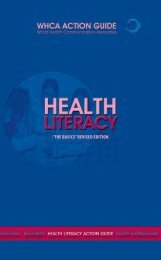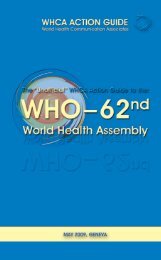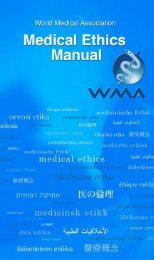Part 1 'the basics' - World Health Communication Associates
Part 1 'the basics' - World Health Communication Associates
Part 1 'the basics' - World Health Communication Associates
You also want an ePaper? Increase the reach of your titles
YUMPU automatically turns print PDFs into web optimized ePapers that Google loves.
obstacles to health education initiatives<br />
The <strong>World</strong> <strong>Health</strong> Organization (1996) has described several barriers that may impede<br />
the implementation of school health programmes. Firstly, policy makers and political<br />
leaders, as well as the public at large, often do not fully understand the true impact<br />
of modern school health programmes on health. Secondly, some may not support<br />
the programmes because the content is considered too controversial, for example<br />
those that discuss HIV infection, other prevalent STDs and unintended pregnancy.<br />
Thirdly, modern school health programmes require effective collaboration, especially<br />
between separate education and health agencies (IOM 2004, p.145). Any planned<br />
educational intervention will need to address these potential obstacles.<br />
4.3 media marketPlaces<br />
For many people media marketplaces—including print, radio, television, internet,<br />
mobile phones and public advertising spaces—are a main source of health<br />
information. These marketplaces shape people’s health perceptions, behaviours<br />
and choices even though they often contain information of variable quality that can<br />
be more confusing than helpful. Separating fact from fiction requires some welldeveloped<br />
health literacy skills. National health information services, like the NHS<br />
Direct in the UK (http://www.nhsdirect.nhs.uk/), can help provide support to people<br />
in deciphering and navigating these health information marketplaces. Some basic<br />
quality control standards and certifications, such as the <strong>Health</strong> On the Net (HON)<br />
standards (http://www.hon.ch/HONcode/Conduct.htm), have been developed for<br />
health web pages but have not yet been applied globally and have not been shown to<br />
make websites easier to understand.<br />
Commercial and political interests often dominate the media marketplaces.<br />
Industries, such as tobacco, alcohol and fast food companies, use sophisticated<br />
communication techniques which glamourise and promote unhealthy products<br />
and lifestyles. Recognising and countering these negative health messages require<br />
literacy skills to distinguish credible, reliable and independent information from<br />
sales-driven product marketing and advertising.<br />
interventions<br />
Increasingly, public health advocates and educators are using a wide range of<br />
technologies, media and social marketing approaches to get independent, evidencebased<br />
information to stand out and shape people’s perceptions, choices and<br />
behaviours.<br />
Section 4: wHat can we do to StrenGtHen HealtH literacy? 25






